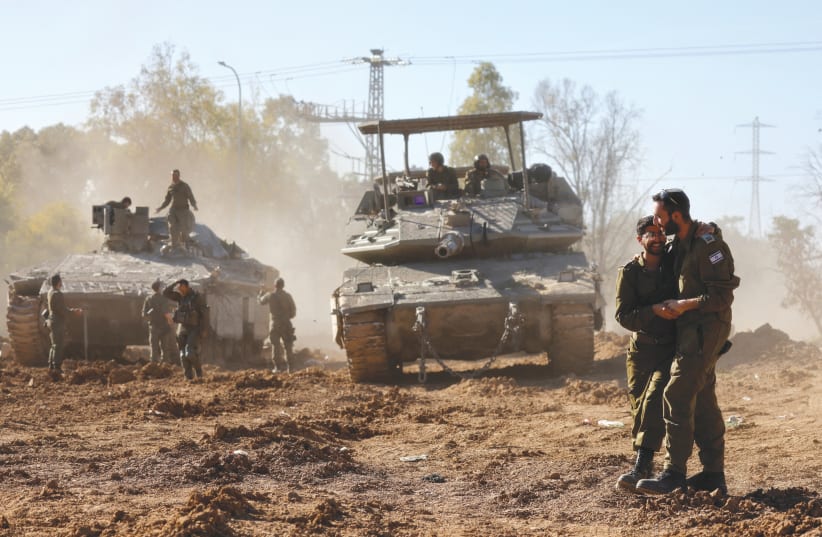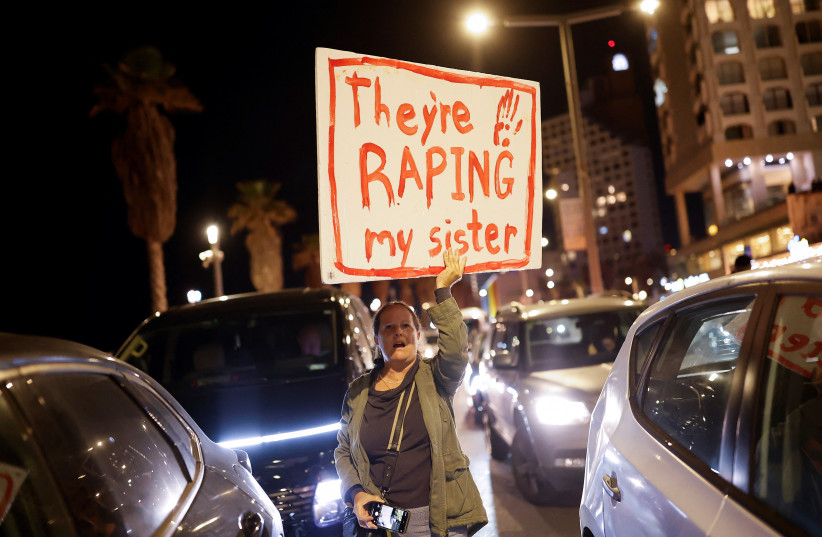There are different types of hatred. In racist societies they hate people because of their skin color, in homophobic societies they hate people because of their sexual orientation, and in polarized societies there is a jump in a very specific kind of hatred: In these societies, people hate people because of their political opinions.
In an ideal world, disagreement does not necessarily lead to a rise in hatred. But we do not live in an ideal world. The digital revolution created a reality where ideological division transforms at the speed of light into emotional division. In this new reality, where disagreement prevails, so do hatred and disgust.
This is a global phenomenon. In the past, right-wingers in the US and Europe opposed the concepts of left-wing ideology, but they did not cancel left-wingers personally. In the past, left-wingers were capable of despising right-wing ideology, while still liking right-wingers personally. These days have passed. In a polarized society, it is hard to rule out a competing ideology without a wholesale cancellation of those who believe in it. Each side attributes evil intentions and negative characteristics to the other side, imagining that those who populate the opposing camp have rotten, corrupt personalities.
In a poll conducted in the US in the sixties, Americans were asked whether it would bother them if their son or daughter married someone with the opposite political opinions. Republicans were asked whether it would bother them if their children married someone who supports the Democratic Party, and vice versa. In the sixties, this bothered just 4% of the respondents. In recent years, this poll was conducted again, and the responses changed radically. Today, it would bother more than 50% of Americans if their children married someone from the other side of the political divide.
These findings have dramatic implications: If 50% oppose marriage between partners belonging to different political camps, that means half of American citizens identify such marriages as a type of “intermarriage.” In the past, this term was reserved for marriage between members of different religions, but today it also applies to marriage between those who identify with different political camps. Following the digital revolution, more and more people look at people from the opposing political camp and view them as a different breed of human being.
In the reserve forces, hatred was wiped out and replaced with comradery, heroism, and solidarity. The tear that mended within the units became a call emerging from within to Israeli society.
A global pandemic
When a virus spreads through the population, a lot of people get sick. But there are differences between patients, based on their levels of sensitivity to the disease. Some suffer from mild symptoms, while others, who are less lucky, develop worrisome symptoms. They experience a severe illness with an increased risk of medical complications.
While the plague of polarization is a global pandemic spreading throughout the world and harming multiple societies, there are differences between societies, depending on their degree of sensitivity and vulnerability.
The State of Israel, it would seem, is a particularly vulnerable society. When Israeli society caught the virus, it got a severe and deadly case which tore it apart and weakened it.
In recent years, and especially during the nine months of conflict over the judicial legislation, polarization’s entire production chain worked overtime in Israel. Disagreement on the ideological level became hatred on the emotional level, blocking any ability for cooperation between camps. Israel’s enemies’ radar picked up this weakness well, and it whetted their appetite. Polarization’s damage sowed indescribable self-destruction in Israeli society.
The alchemy that occurs in people’s conscience in a polarized society is simple and cruel: Whatever they feel toward any given ideology becomes what they feel personally toward people who hold that ideology. A person who is worried about a “left-wing” ideology starts to think very bad thoughts about people who hold left-wing positions. A person who fears the ideology of the “Right” starts to develop feelings of disgust toward people who hold right-wing positions.
Here is an explanation of this phenomenon: A person infected by this virus looks at another person and stops seeing them. They can only see their political opinion, which taints the person completely.
Imagine a shy person who likes tennis, is a top-notch cook with a strange sense of humor, who ascribes to left-wing positions. In a polarized society, this person becomes one thing only: a left-winger. This one detail that is political consumes their image, masking the full diversity of their personality. And when a person becomes their opinion, whatever I feel toward their opinion becomes what I feel toward them.
A detoxification workshop
How can polarization be healed? There is a recipe with three ingredients: bring together people with different opinions, with no digital mediation, over a long period of time.
When this happens, people discover all of each other’s shades and dimensions. They find out, for example, that a person’s right-wing characteristic reflects who they are far less than do their sense of humor, hobbies, and social skills.
When this happens, we grasp that the world of the person before us is broader and richer than their political opinions, which suddenly cease to mask them. And when a person’s politics return to their proper place, the alchemy stops working. What we feel toward the opinion ceases to be what we feel toward the person.
After nine months of national strife, war broke out. More than 300,000 Israelis were called up to the reserves. They convened in units and companies, where Israelis with different opinions and identities rubbed shoulders in the most intensive way imaginable, face-to-face, without digital mediation, over a long period of time. Unwittingly, they underwent a detoxification workshop.
The result was clear and hopeful: In the reserve forces, hatred was wiped out and replaced with comradery, heroism, and solidarity. The melting pot of the new Israel was created in the reserve forces.
The tear that mended within the units became a call emerging from within to all of Israeli society: They demand that we, the Israelis who did not undergo the workshop for polarization detoxification, rise above the strong urges to resume arguing.
One of these reservists, the singer, actor, and Israeli hero Idan Amedi, put it this way: “Right now this people does not have the ability to withstand these stupid disputes. There is simply no air for that. All the air is directed toward processing the pain, extending a hand to our brothers and sisters fighting on the different fronts.
“Stop clashing on Twitter, in studios, in press conferences. We need you to stop. We need you to let us be unified until we annihilate those who wish to destroy us.”
The tragedy that occurred this week in the Gaza Strip, in which 21 soldiers fell, reminds us of the high price the reservists pay, and how greatly indebted we are to them. And they, the reservists, know how we can repay them: by not quarreling again.
From a psychological and sociological standpoint, the reserve forces succeeded in creating a community that scarcely exists today in the entire Western world. This kind of community has two qualities that do not usually come together: diversity and cohesion.
Usually, where there is political diversity, there is no cohesion; and where there is cohesion, there is no diversity. During the nine months of conflict, whenever we saw a cohesive group, we knew with a high level of certainty that this was a homogeneous group, whose members all held the same worldview. On the other hand, wherever we saw a high degree of diversity, we knew there was no cohesion. This happened even within families, which could not sit together around the Passover Seder table.
And then the war broke out, and the reserve forces appeared and presented to Israeli society a model of community that breaks all the invisible rules created by the digital revolution. This is a community that is diverse and cohesive at the same time.
A war that brings peace
During the period that preceded independence, and in the state’s first years, many Israelis viewed the kibbutz as a model Israeli society. They looked at the communal, egalitarian, and pioneering lifestyle of the kibbutz, and they were inspired. The egalitarian nationalistic tendencies that characterized many Israelis during those times stemmed inter alia from inspiration from the kibbutz.
By the nineties, Israelis were no longer inspired by the kibbutz. During that period, hi-tech start-ups started popping up one after the other. In the beginning of the 21st century, these companies made great strides, presenting a new kind of model. Israelis looked at how a few entrepreneurs dreamt a dream together and set out to realize it, demonstrating innovation, boldness, and creativity, and this inspired them.
In the past, tourists and volunteers from all over the world came to Israel to get to know the kibbutz from inside. Since the beginning of the present century, tourists and groups from throughout the world have been arriving in Israel to learn about the wonder of Israeli hi-tech. The kibbutz represented what was special about Israeli socialism; start-up companies represented what was special about Israeli capitalism.
In 2023, a new, updated model society was born: the reserve forces. These communities are not a model of socialist ideology, like the kibbutz, or of capitalist ideology, like hi-tech. These are model communities that symbolize the ability to rise above ideologies.
When we look up to something, we change. A society that looks up to rich people is a society with materialistic tendencies. A society that looks up to sports stars is probably an athletic society. A society that looks up to intellectuals is probably a society with a high level of literacy. A society that looks up to generals is probably a society with militaristic tendencies. What we admire changes us; some of its qualities become a part of us.
What does a society that looks up to the reserve forces with wonder and admiration look like? When we look up to how the reservists make sacrifices, we also breathe in part of their unity and cohesion.
These new model communities are an unplanned by-product of the war. These are communities made of thousands of male and female reservists, who left their homes to fight against Israel’s enemies, and in fact are bringing peace within Israel.
The writer is the author of the books Catch-67, The Last Words of Moses, The Dream of the Kuzari, and Maimonides and the Book That Changed Judaism: Secrets of The Guide for the Perplexed. His new book, which deals with the conflict and the war, will be released after Purim.
This article was originally published in Hebrew in Makor Rishon. It is republished here with permission.

